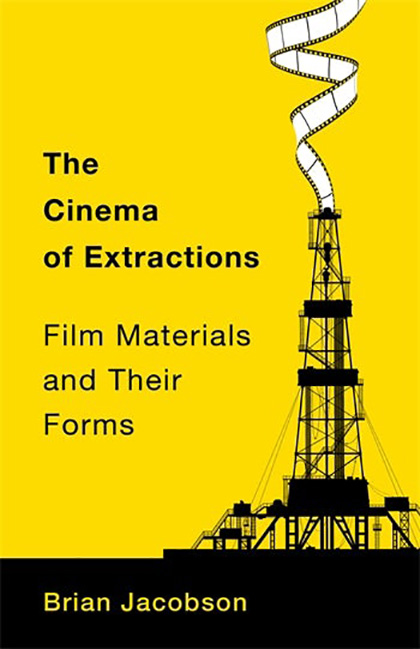Critical Inquiry Critical Inquiry
Brian Jacobson. The Cinema of Extractions: Film Materials and Their Forms. New York: Columbia University Press, 2025. 227 pp.
Review by Parker Stenseth
3 October 2025
In a year when the United States has reaffirmed its commitment to extraction industries while parts of the world explore renewable futures, it is necessary to question our persistent attachment. In The Cinema of Extractions, Brian Jacobson does so by analyzing cinema’s world-making qualities through what he presents as a dialectical relationship between film materials and their forms. While most materialist accounts of cinema and extraction focus primarily on material substrates, Jacobson “seeks a formalism formed in dialogue with historical, materialist, and historical materialist methods” (p. 8). The readings produced by his formalism describe a “relationship between media and extraction, in which media act as world-defining agents of the extractive industries upon which they depend and the extracted materials become visible and knowable as more-than-material components (for example, images, symbols, and spectacles) of modern life” (p. 106). Such a relationship is anchored in the cinema’s technological origins and its reliance on extracted materials and belies an indebtedness “to capitalist industries’ defining ambitions for world creation and domination, including colonial domination and its associated racial and ethnic subjugation” (p. 14).
Jacobson’s framework for close reading, developed in the introduction from the work of Louis Hjelmslev, bridges four categories of analysis: substance of content, form of content, substance of expression, and form of expression. In selecting objects for his chapters, Jacobson prioritizes films “that generate complex reflexive readings” (p. 24). For example, in the first half of the book, he recounts a history of early cinema and its eventual industrialization as a history of extraction and resource integration, moving from films such as Lumière actualities and the Westinghouse Works to early studio pictures. The second chapter begins with a productive rereading of The Lonedale Operator (dir. D. W. Griffith, 1911), which centers on the synchronization of the form of its content and the form of its aesthetic. For example, the famous crosscutting is motivated by the transportation of money and extracted resources for the Lonedale Mining Company, and it mirrors the telegraph communication in the film made possible through mined copper. Without extraction industries, the world of the film would not exist, and neither would the film.
The third chapter provides perhaps the most substantive demonstration of cinema’s material substrates’ ties to aesthetic expression. It turns to carbon and tungsten as two elements that shaped over a century of cinematic lighting. Jacobson illuminates how an industrial film about tungsten both represents the step-by-step process by which the raw material is made useful and demonstrates its usefulness by providing light for the film’s production and projection. This becomes a complex instrumentalization process that Jacobson argues extends to public interest as an essential component of the world-making endeavor. He comes to articulate the corresponding forms as a “prosaic poetics,” a “banal but important formal system through which corporate-produced films sought to shape broad understandings and opinions about their work . . . to create the worlds, and formal systems, in which their products could succeed” (p. 80). Jacobson expands on this concept in the fourth chapter. His analysis of Shellarama (dir. Richard Cawston, 1965) demonstrates how the film’s tracking shots align with the material forms of its content, oil infrastructure, before using similar tracking shots for immaterial expressions of oil’s use as energy, which posits a more-than-material cultural form. Not only are these tracking shots a question of morality, they are, as Jacobson argues, traces of the social processes and practices that undergird an empire of extraction.
Jacobson remarks in the book’s acknowledgments that The Cinema of Extractions emerged during work on a different project as he reflected on the relationship between Cinema and Media Studies and extraction and materiality. In this sense, the text is a meditation on discipline and remains committed to the tools that have come to define the disciplinary orientation. It is not surprising, then, that the book is so indebted to Tom Gunning’s influential work on the “cinema of attractions.”[1] While the cinema of attractions seeks to reframe the relationship between spectators and the early cinema, Jacobson promotes an unsettled perspective on the relationship between the film text and its mode of production. He concludes the book by inviting readers to consider how his framework might apply to other objects, a universalization of the concept that recalls how many scholars evoke the cinema of attractions as a heuristic for a particular mode of reception. While Jacobson’s book largely focuses on industrial films, where the most reflexive readings are found, there are modes of cinema in the peripheries of The Cinema of Extraction that are beyond the intended scope of the short book, but perhaps like Gunning’s “cinema of attractions,” its allure partially resides in the way others might test the limits of its application.
[1] See Tom Gunning, “The Cinema of Attractions: Early Film, Its Spectator, and the Avant-Garde,” Wide Angle 8, no. 3–4 (1986): 63–70.

